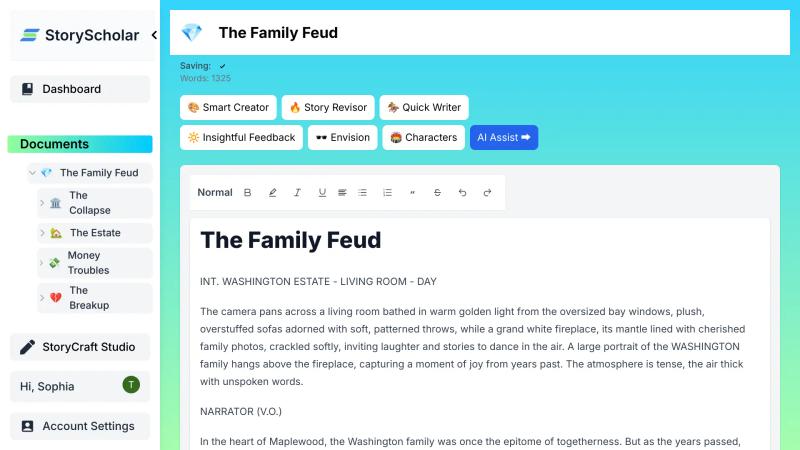Creating a compelling character arc is one of the cornerstones of effective storytelling. A character arc represents the transformation or development your character undergoes throughout the narrative, making them relatable and memorable to readers.
Whether you're crafting a hero's journey, a villain's downfall, or a character who remains steadfast in their beliefs, a well-defined character arc adds depth and dimension to your story. But how can writers effectively craft these arcs in a way that feels organic and nuanced?
Enter artificial intelligence (AI), a powerful tool that can assist in developing dynamic character arcs. So, let's explore how you can harness AI to create unforgettable character journeys.

Understanding Character Arcs
But before we dive into the mechanics of using AI, it’s essential to understand what a character arc truly is. A character arc is the emotional journey a character experiences, typically characterized by change, growth, or realization. This journey can be broken down into three primary types:
- Positive Arc: The character evolves positively, overcoming obstacles and growing in the process. For example, consider a character who starts off insecure and gradually gains confidence through a series of challenges.
- Negative Arc: The character's journey leads to a decline or moral compromise. A classic example is a once-noble character who succumbs to ambition and corruption.
- Flat Arc: The character remains mostly unchanged but has a significant impact on the world around them. Think of a wise mentor who remains constant but influences the growth of others.
Understanding these arcs allows you to better plan the emotional trajectory of your character, ensuring they resonate with your audience. A well-crafted arc keeps readers invested in your character’s journey, making them care about their fate and decisions.

The Role of AI in Developing Character Arcs
So, how does AI fit into this creative process? AI tools can assist writers in various ways, from generating ideas to providing feedback on character development. By using AI, you can explore new dimensions of your character, make informed decisions about their journey, and ultimately enhance the storytelling experience.
AI tools can help with:
- Idea Generation: Stuck on a character's motivation or backstory? AI can provide suggestions based on genres, archetypes, and common tropes.
- Conflict Resolution: Identify plot holes or inconsistencies in your character’s journey. AI can help you brainstorm ways to resolve these issues.
- Feedback: AI can analyze your character arc and offer insights into pacing, emotional impact, and coherence.
Overall, AI serves as a valuable resource for enhancing creativity and reducing the time spent on character development.
Steps to Create a Character Arc Using AI
Step 1: Define Your Character's Goals
The first step in writing a character arc is to clearly define your character's goals. What drives them? What do they want to achieve? This could range from personal ambitions, such as finding love or seeking revenge, to broader objectives like saving the world. Understanding their motivations is crucial for mapping out their journey, as it gives context to their actions and decisions.
Example Prompt for AI: "Generate a list of potential character goals for a young adult fantasy protagonist."
By using AI to brainstorm character goals, you can expand your options and discover new directions for your character's journey that you may not have considered.
Step 2: Identify the Starting Point
Next, determine where your character begins their journey. What are their flaws, fears, or limitations? This starting point is essential for understanding the transformation they will undergo throughout the story.
For example, if your character is a talented but arrogant musician, their journey might involve learning humility and the value of collaboration. AI can help you identify these traits by generating lists of common character flaws or strengths.
Example Prompt for AI: "What are some common character flaws for a protagonist in a coming-of-age story?"

Step 3: Map Out the Transformation
Now, it’s time to outline how your character will evolve. What key moments will challenge them and prompt growth or change? This step involves defining specific events that push your character out of their comfort zone and force them to confront their flaws.
For instance, if your character's goal is to become a successful artist, they might face a series of rejections, meet a mentor who challenges their perspective, or experience a personal loss that reshapes their priorities. AI can assist by suggesting potential plot points that align with your character’s goals and flaws.
Example Prompt for AI: "Help me outline a character arc for a protagonist who learns to embrace vulnerability."

Step 4: Utilize AI for Brainstorming
But what if you experience writer’s block or struggle to flesh out your character’s arc? This is where an AI tool like Storyscholar can be beneficial. Storyscholar is designed specifically for authors, helping you brainstorm ideas and develop character arcs in a structured manner. You can input your character's goals, starting point, and transformation ideas, and the AI can suggest new directions or conflicts to explore.
For example, you might input your character's initial goal, and Storyscholar can generate potential challenges they might face or relationships that could influence their journey. This interactive approach not only sparks creativity but also enriches the narrative with depth and complexity.
Step 5: Refine and Expand with AI Feedback
Once you have a rough outline of your character arc, it’s time to refine it. StoryScholar can provide feedback on your character's journey, helping you identify inconsistencies or areas that may need more depth. By utilizing its capabilities, you can ensure that your character’s transformation feels authentic and well-developed.
For instance, if a plot twist feels out of character or your character's motivations seem unclear, you can ask StoryScholar to analyze the arc and suggest adjustments. This iterative process allows for continuous improvement and enhances the overall quality of your writing.

Additional Tips for Creating a Memorable Character Arc
- Show, Don’t Tell: Use actions and dialogue to illustrate your character's growth rather than stating it outright. Show how their experiences shape their behavior and perspective.
- Incorporate Subplots: Subplots can serve as a backdrop to your character's journey, providing additional layers of conflict and growth. Consider how secondary characters impact your main character's arc.
- Use Symbolism: Objects, settings, or recurring themes can symbolize your character's journey and transformation. This adds depth and richness to their story.
- Test Your Arc: Share your character arc with trusted peers or writing groups for feedback. Different perspectives can highlight areas for improvement and enhance your character's journey.
Conclusion
In conclusion, writing a character arc using AI can greatly enhance your storytelling process. By leveraging tools like StoryScholar, you can streamline your character development, explore new ideas, and create arcs that resonate deeply with readers. The combination of traditional writing techniques and advanced AI technology opens up a world of possibilities for crafting compelling character journeys.
So, whether you are a seasoned author or just starting, consider integrating AI into your writing process to elevate your character arcs and enrich your narratives. The journey of character development is one that requires both creativity and structure, and AI can be your ally in navigating this exciting process.

